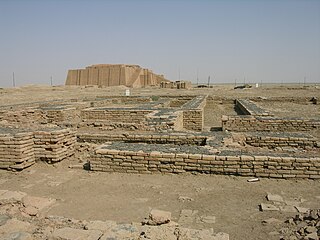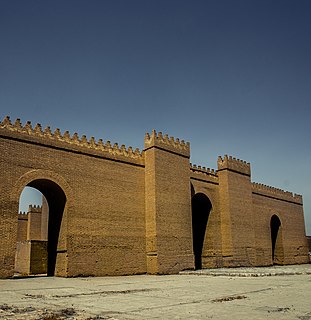
Assyria, also at times called the Assyrian Empire, was a Mesopotamian kingdom and empire of the Ancient Near East that existed as a state from perhaps as early as the 25th century BC until its collapse between 612 BC and 609 BC, thereby spanning the periods of the Early to Middle Bronze Age through to the late Iron Age. This vast span of time is divided into the Early Period, Old Assyrian Empire, Middle Assyrian Empire and Neo-Assyrian Empire. A Semitic-speaking realm, Assyria was centred on the Tigris River in Upper Mesopotamia, a region which covered, in modern terms, northern Iraq, northeast Syria, and southeast Turkey, with fringe areas of northwest Iran. After its fall Assyria remained a geo-political entity under the control of various empires until the mid-7th century AD.

Chaldea was a small country that existed between the late 10th or early 9th and mid-6th centuries BCE, after which the country and its people were absorbed and assimilated into the indigenous population Babylonia. Semitic-speaking, it was located in the marshy land of the far southeastern corner of Mesopotamia and briefly came to rule Babylon. The Hebrew Bible uses the term כשדים (Kaśdim) and this is translated as Chaldaeans in the Greek Old Testament, although there is some dispute as to whether Kasdim in fact means Chaldean or refers to the south Mesopotamian Kaldu.

Mesopotamia is a historical region of Western Asia situated within the Tigris–Euphrates river system, in the northern part of the Fertile Crescent. Mesopotamia occupies most of present-day Iraq and Kuwait. The historical region includes the head of the Persian Gulf and parts of present-day Iran, Syria, and Turkey.

Ur was an important Sumerian city-state in ancient Mesopotamia, located at the site of modern "Tell el-Muqayyar" in south Iraq's Dhi Qar Governorate. Although Ur was once a coastal city near the mouth of the Euphrates on the Persian Gulf, the coastline has shifted and the city is now well inland, on the south bank of the Euphrates, 16 kilometres from Nasiriyah in modern-day Iraq. The city dates from the Ubaid period circa 3800 BC, and is recorded in written history as a city-state from the 26th century BC, its first recorded king being Mesannepada.

Babylonia was an ancient Akkadian-speaking state and cultural area based in central-southern Mesopotamia. A small Amorite-ruled state emerged in 1894 BC, which contained the minor administrative town of Babylon. It was merely a small provincial town during the Akkadian Empire but greatly expanded during the reign of Hammurabi in the first half of the 18th century BC and became a major capital city. During the reign of Hammurabi and afterwards, Babylonia was called "the country of Akkad", a deliberate archaism in reference to the previous glory of the Akkadian Empire.

Akkadian is an extinct East Semitic language that was spoken in ancient Mesopotamia from the third millennium BC until its gradual replacement by Akkadian-influenced Old Aramaic among Mesopotamians by the 8th century BC.

Sumer is the earliest known civilization in the historical region of southern Mesopotamia, emerging during the Chalcolithic and early Bronze Ages between the sixth and fifth millennium BC. It is also one of the first civilizations in the world, along with ancient Egypt, the Caral-Supe civilization, the Indus Valley civilization, the Minoan civilization, and ancient China. Living along the valleys of the Tigris and Euphrates, Sumerian farmers grew an abundance of grain and other crops, the surplus from which enabled them to form urban settlements. Proto-writing dates back before 3000 BC. The earliest texts come from the cities of Uruk and Jemdet Nasr, and date to between c. 3500 and c. 3000 BC.

Mesopotamian religion refers to the religious beliefs and practices of the civilizations of ancient Mesopotamia, particularly Sumer, Akkad, Assyria and Babylonia between circa 3500 BC and 400 AD, after which they largely gave way to Syriac Christianity practiced by today’s Assyrians. The religious development of Mesopotamia and Mesopotamian culture in general, especially in the south, was not particularly influenced by the movements of the various peoples into and throughout the area. Rather, Mesopotamian religion was a consistent and coherent tradition which adapted to the internal needs of its adherents over millennia of development.
Akkadian literature is the ancient literature written in the Akkadian language in Mesopotamia during the period spanning the Middle Bronze Age to the Iron Age.

The Kassites were people of the ancient Near East, who controlled Babylonia after the fall of the Old Babylonian Empire c. 1595 BC and until c. 1155 BC. The endonym of the Kassites was probably Galzu, although they have also been referred to by the names Kaššu, Kassi, Kasi or Kashi.

The Culture of Iraq or The Culture of Mesopotamia is one of the world's oldest cultural histories and is considered one of the most influential cultures in the world. The region between the Tigris and Euphrates rivers, historically known as Mesopotamia, is often referred to as the Cradle of civilisation. Mesopotamian legacy went on to influence and shape the civilizations of the Old World in different ways such as inventing writing. Iraq is home diverse ethnic groups and has a very long and rich heritage. The country is known for its poets، architects، painters and sculptors who are among the best in the region, some of them being world-class. Iraq is known for producing fine handicrafts, including rugs and carpets among many other things.
Assyriology is the archaeological, historical, and linguistic study of Assyria and the rest of ancient Mesopotamia and of the related cultures that used cuneiform writing. The field covers Sumer, the early Sumero-Akkadian city-states, the Akkadian Empire, Ebla, the Akkadian and Imperial Aramaic speaking states of Assyria, Babylonia and the Sealand Dynasty, the migrant foreign dynasties of southern Mesopotamia, including the Gutians, Amorites, Kassites, Arameans, Suteans and Chaldeans, and to some degree post-imperial Achaemenid Assyria, Athura, Eber-Nari, Assyria, and Assuristan, together with later Neo-Assyrian states such as Adiabene, Osroene, Hatra, Beth Nuhadra and Beth Garmai, until the Arab invasion and Islamic conquest of the mid-7th century AD. Some Assyriologists also write on the further Assyrian continuity of the Assyrian people as well as the Mandaeans to the present.

Iraqi people are people who originate from the country of Iraq.

The (pre)history of Mesopotamia ranges from the earliest human occupation in the Paleolithic period up to the Late antiquity. This history is pieced together from evidence retrieved from archaeological excavations and, after the introduction of writing in the late 4th millennium BC, an increasing amount of historical sources. While in the Paleolithic and early Neolithic periods only parts of Upper Mesopotamia were occupied, the southern alluvium was settled during the late Neolithic period. Mesopotamia has been home to many of the oldest major civilizations, entering history from the Early Bronze Age, for which reason it is often dubbed the cradle of civilization.

Babylon was the ancient city where some of the most influential empires of the ancient world ruled. It was the capital of the Babylonian empire and it was considered to be a center of commerce, art, and learning and is estimated to have been the largest early city in the world, perhaps the first to reach a population above 200,000.

The ancient Near East was the home of early civilizations within a region roughly corresponding to the modern Middle East: Mesopotamia, ancient Egypt, ancient Iran, Anatolia/Asia Minor and the Armenian Highlands, the Levant, Cyprus and the Arabian Peninsula. The ancient Near East is studied in the fields of Ancient Near East studies, Near Eastern archaeology and ancient history.
The Kingdom of Khana or Kingdom of Hana was a Syrian Kingdom from Hana Land located in the middle Euphrates region north of Mari which included the ancient city of Terqa. The kingdom emerged during the decline of the First Babylonian Dynasty. A newer view is that only the initial six rulers lived during that time and after an interregnum, Khana re-emerged in the Middle Babylonian period under the last six kings. It was located on the middle Euphrates close to the junction of Khabur River. Its capital was the town of Terqa.

The Amorites were an ancient Northwest Semitic-speaking people from the Levant who also occupied large parts of southern Mesopotamia from the 21st century BC to the end of the 17th century BC, where they established several prominent city-states in existing locations, such as Isin, Larsa and later notably Babylon, which was raised from a small town to an independent state and a major city. The term Amurru in Akkadian and Sumerian texts refers to the Amorites, their principal deity and an Amorite kingdom.
Ancient Semitic-speaking peoples or Proto-Semitic people were Western Asian people who lived throughout the ancient Near East, including the Levant, Mesopotamia, the Arabian Peninsula, and the Horn of Africa from the 3rd millennium BC until the end of antiquity.













